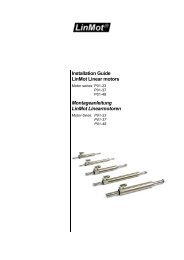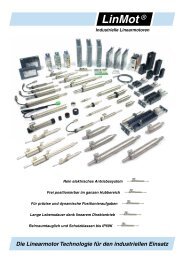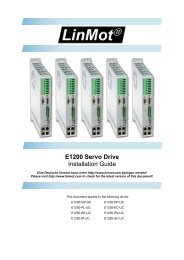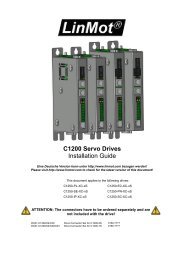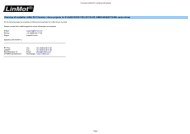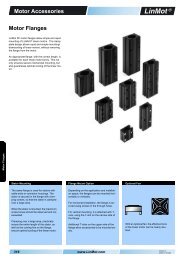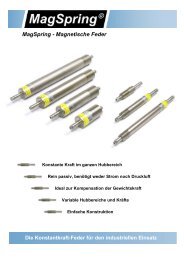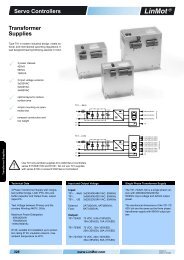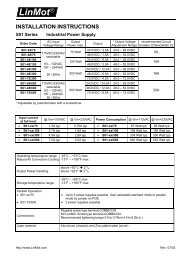Datenblatt Linearmotor P001-25x25x200 - LinMot
Datenblatt Linearmotor P001-25x25x200 - LinMot
Datenblatt Linearmotor P001-25x25x200 - LinMot
You also want an ePaper? Increase the reach of your titles
YUMPU automatically turns print PDFs into web optimized ePapers that Google loves.
Contents<br />
1. PLC/PC with analog interface...........................................................................................3<br />
Move to freely adjustable positions................................................................................................... 3<br />
2. PLC/PC with digital output................................................................................................5<br />
Replacement of pneumatic cylinder.................................................................................................. 5<br />
3. PLC/PC run profile movement ..........................................................................................7<br />
Pick and Place application ............................................................................................................... 7<br />
4. Velocity control by PLC/PC...............................................................................................9<br />
Synchronization to conveyer velocity ............................................................................................... 9<br />
5. Supervision of trailing errors (following error)..............................................................11<br />
Detection of blocked packets.......................................................................................................... 11<br />
6. Position-Feedback to PLC/PC ........................................................................................13<br />
Collision safety............................................................................................................................... 13<br />
7. End position feedback (AT-electronic unit) ...................................................................15<br />
Monitoring of the end position ........................................................................................................ 15<br />
8. PLC/PC controls multiple positions/profiles..................................................................17<br />
Change between different tasks ..................................................................................................... 17<br />
9. PLC/PC starts incremental movement ...........................................................................19<br />
Linear motor plays stepper motor ................................................................................................... 19<br />
10. Teach-In procedure (MT-Mode) ....................................................................................21<br />
Roboter and handling applications with teach-in ............................................................................. 21<br />
11. End position feedback (MT-Mode)................................................................................23<br />
Monitoring of the end position ........................................................................................................ 23<br />
12. PLC/PC controls force ..................................................................................................25<br />
Press part into form........................................................................................................................ 25<br />
13. Unlimited number of steps (stepper motor).................................................................27<br />
Stepper motor continuously rotating ............................................................................................... 27<br />
14. Multiple axle application ...............................................................................................29<br />
Handling machine with round table................................................................................................. 29<br />
15. RS-232 interfacing.........................................................................................................33<br />
Press part into form........................................................................................................................ 33<br />
16. Stop situations...............................................................................................................37<br />
Go to special stop position ............................................................................................................. 37<br />
17. Check whether movement space is free......................................................................39<br />
Check if any blocked package are in front of the motor .................................................................. 39<br />
18. Application ‘Jog’...........................................................................................................41<br />
Remote control of <strong>LinMot</strong>® with buttons......................................................................................... 41<br />
19. Positioning with 10 µm repeatability ............................................................................43<br />
Configuration with external position sensing ................................................................................... 43<br />
20. Improved linearity with external position sensing.......................................................47<br />
Configuring the external position sensing ....................................................................................... 47<br />
21. Operating 2 motors in parallel ......................................................................................49<br />
Force multiplication to raise the dynamics......................................................................................49<br />
22. Operating 4 motors in parallel ......................................................................................51<br />
Paralleling to raise the peak force .................................................................................................. 51<br />
23. PLC/PC with PROFIBUS-DP master selection .............................................................53<br />
Moving into any position ................................................................................................................. 53<br />
24. Control through force....................................................................................................55<br />
Interface to a Delta Tau PMAC motion control board...................................................................... 55<br />
Education_Examples-V1.4e.doc www.<strong>LinMot</strong>.com 990528<br />
1
Specification of products are subject to change without notification<br />
Education_Examples-V1.4e.doc www.<strong>LinMot</strong>.com 990528<br />
2
1. PLC/PC with analog interface<br />
Move to freely adjustable positions<br />
Task description<br />
An adjustable linear movement is needed for laboratory equipment. The movement is<br />
calculated on-line by a PC or by a PLC and takes place within the range 20 mm to 70<br />
mm. It should be possible to move to every position within this range.<br />
For safety reasons acceleration should never be greater than 75 m/s2 and the velocity<br />
should never exceed 1,6 m/s<br />
Additional task<br />
Reduce the max velocity to 0,2 m/s.<br />
Position 1: 22 mm<br />
Position 2: 55 mm<br />
Position 3: 27 mm<br />
Position 4: 55 mm<br />
…<br />
Position xx: 48 mm<br />
Digital Outputs<br />
Analog Outputs<br />
E400-AT<br />
Education_Examples-V1.4e.doc www.<strong>LinMot</strong>.com 990528<br />
3
Solution<br />
Position specification over 0 -10 V interface with limitation of acceleration and velocity.<br />
1. Selection of ‘Run’ mode<br />
2. Specification of the scaling range 0 -10V Æ 0 -70 mm<br />
3. Limitation of velocity and acceleration<br />
Other solution:<br />
Use RS-232/485 or Profibus<br />
Education_Examples-V1.4e.doc www.<strong>LinMot</strong>.com 990528<br />
4
2. PLC/PC with digital output<br />
Replacement of pneumatic cylinder<br />
Task description<br />
In an automation mechanism, a point to point movement from 22 mm to 68mm is<br />
needed. Acceleration may never become larger than 20 m/s2 and the velocity should<br />
be limited to 0,5 m/s. The superordinate control consists of a small PLC, which has four<br />
free digital outputs.<br />
Additional task<br />
Now make the same PLC control up to 10 different positions. Every position should<br />
have a dedicated acceleration and velocity limitation.<br />
Position 1: 22 mm<br />
Position 2: 68 mm<br />
Digital Outputs<br />
E400-AT<br />
Education_Examples-V1.4e.doc www.<strong>LinMot</strong>.com 990528<br />
5
Solution<br />
Use ‘Two point’ digital mode and limit acceleration and velocity.<br />
1. Mode ‘Two Point’<br />
2. Define the positions<br />
3. Define acceleration and velocity limitations<br />
Additional task :<br />
Use Multitrigger Electronics and all four digital outputs of the PLC<br />
Education_Examples-V1.4e.doc www.<strong>LinMot</strong>.com 990528<br />
6
3. PLC/PC run profile movement<br />
Pick and Place application<br />
Task description<br />
In an automated mechanism a ‘pick and place' movement is needed. The first movement<br />
goes from 30 mm to 70 mm, whereby the moving time may amount to 50ms. In<br />
order to avoid damage, the return motion must occur relatively slowly. Therefore a max.<br />
acceleration of 20 m/s2 and a deceleration of 10 m/s2 are specified. The velocity<br />
should never exceed 1,5 m/s.<br />
The superordinate control consists of a small SPS, which has four free digital outputs.<br />
Additional Task<br />
How could the same PLC drive up to 9 different pick and place movements ?<br />
Move: 30 Æ 70 mm / 50 ms<br />
Move : 70 Æ 30 mm / 20 m/s 2 and 10 m/s 2<br />
v max : 1.5m/s<br />
4 digital Outputs<br />
Education_Examples-V1.4e.doc www.<strong>LinMot</strong>.com 990528<br />
7
Solution<br />
Position specification over trigger mode. The pick profile is produced with 'minimum jerk<br />
'. For the place movement, the 'Point to point' function in the Curve Inspector is used.<br />
1. Select : Trigger Curve<br />
2. Rising edge enables curve 1, falling edge is going to start curve 2<br />
3. Create curves using the ‘Curve Inspector’<br />
Pick movement: Minimal Jerk<br />
Place movement: Point to Point<br />
Additional task:<br />
Use Multitrigger electronic unit and all four digital outputs of the PLC<br />
Education_Examples-V1.4e.doc www.<strong>LinMot</strong>.com 990528<br />
8
4. Velocity control by PLC/PC<br />
Synchronization to conveyer velocity<br />
Task description<br />
In an automated mechanism a candy is to be shifted onto a conveyor belt moving at a<br />
velocity of 0,8 m/s. In order to avoid damages or in order an exact adjustment of the<br />
candies, the shifting movement should be done at almost the same velocity of the conveyor.<br />
The superordinate control unit consists of a small PLC, which has only digital<br />
outputs.<br />
Additional task<br />
How could the production speed be improved?<br />
Length of the candy ca. 50 mm<br />
Velocity of the conveyer: V:= 0.8 m/s<br />
Education_Examples-V1.4e.doc www.<strong>LinMot</strong>.com 990528<br />
9
Solution<br />
Use ‘two point’ mode and limit the velocity to 0.8 m/s.<br />
1. Mode: Two Point<br />
2. Limitof the velocity to 0.8 m/s<br />
Additional task<br />
By using a profile (curve mode) instead of a simple two point movement the speed of<br />
the returnmovement could be increased<br />
Education_Examples-V1.4e.doc www.<strong>LinMot</strong>.com 990528<br />
10
5. Supervision of trailing errors (following error)<br />
Detection of blocked packets<br />
Task description<br />
Packages are placed in a handling machine. Some of the packages are badly assembled,<br />
so there is a risk that some of them block the mechanism. When this happens, the<br />
handling machine must be stopped immediately.<br />
Stroke: 120 mm<br />
Velocity: 1.1 m/s<br />
Acceleration: 30 m/s 2<br />
There is only an E400-AT electronic unit available to do the task.<br />
Additional task<br />
How can you ensure that the blocked packages are not destroyed as they pass through<br />
the motors?<br />
Education_Examples-V1.4e.doc www.<strong>LinMot</strong>.com 990528<br />
11
Solution<br />
Use two point mode. Adjust the max. velocity to 1.1 m/s. Set max. acceleration to 30<br />
m/s2. Monitor the error limit. As soon as the trailing error is larger than 2 mm, a warning<br />
will be sent. The superordinate control unit can stop the machine.<br />
1. Select mode: Two Point and specify the stroke<br />
2. Limit velocity and acceleration<br />
3. Define trailing error band (called following error)<br />
4. Enable ‚Warn Mask‘ on drive level<br />
5. Disable additional possibilities of the ‚Warn Mask‘ on system level<br />
Additional task<br />
Activate force limiter (max. current)<br />
Education_Examples-V1.4e.doc www.<strong>LinMot</strong>.com 990528<br />
12
6. Position-Feedback to PLC/PC<br />
Collision safety<br />
Task description<br />
two movements interlink in a handling machine. In order to be certain of avoiding a collisionthe<br />
linear motor will generate a signal, if the two movements pass within a<br />
distance of between 50 to 75 mm. The stroke range of the linear motor is from 20<br />
to 90 mm, whereby the velocity must be limited to 0,5 m/s.<br />
the only control unit available is the E400-AT .<br />
Education_Examples-V1.4e.doc www.<strong>LinMot</strong>.com 990528<br />
13
Solution<br />
Use two point mode. Limit velocity and acceleration (0.5 m/s, e.g. to 30 m/s2). Set 'Pos<br />
Range ' to 50 to 75 mm. As soon as the slider is in the area between 50 to 75 mm, a<br />
'pos error ' signal is activated.<br />
1. Select the stroke using Two Point mode<br />
3. Limit velocity and acceleration<br />
4. Adjust the position band<br />
5. Enable Pos Range Indicator inside the ‚Warn Mask‘ on drive level<br />
Remark: The position range signal is linked to the output ‘Pos Error Output‘ and not to<br />
the ‚Warn Output‘! But it must be enabled inside of the ‚Warn Mask‘.<br />
6. Enable the hardware of the ‚Pos Error Output‘<br />
Education_Examples-V1.4e.doc www.<strong>LinMot</strong>.com 990528<br />
14
7. End position feedback (AT-electronic unit)<br />
Monitoring of the end position<br />
Task description<br />
The superordinate control is to receive a signal, at exactly the moment the linear motor<br />
exactly achieves its final position (range 0,5 mm). The movement goes from 20 mm to<br />
77 mm with a velocity of 0,3 m/s and acceleration of 20 m/s2.<br />
Use an AT-electronic unit.<br />
Education_Examples-V1.4e.doc www.<strong>LinMot</strong>.com 990528<br />
15
Solution<br />
Use Two point mode. Limit velocity and acceleration. Set ‚ Pos Range‘ to 76.5 and 77.5<br />
mm. As soon as the slider will be in the range between 76.5 and 77.5 mm a ‚Pos Error‘<br />
signal will be canceled.<br />
1. Use Two Point mode and adjust the stroke<br />
3. Limit velocity and acceleration<br />
4. Set the position band<br />
5. Enable Pos Range Indicator inside of the ‚Warn Mask‘ on drive level<br />
Remark: The position range signal is linked to the output ‘Pos Error Output‘ and not to<br />
the ‚Warn Output‘! But it must be enabled inside the ‚Warn Mask‘.<br />
6. Enable the hardware of the ‚Pos Error Output‘<br />
Education_Examples-V1.4e.doc www.<strong>LinMot</strong>.com 990528<br />
16
8. PLC/PC controls multiple positions/profiles<br />
Change between different tasks<br />
Task description<br />
A handling machine assembles different parts during the day. Because of this, the<br />
stroke of the motor must be switched as well as all the velocity and acceleration values.<br />
Small parts: 20 mm to 80 mm v max = 1.5 m/s a max := 50 m/s 2<br />
Big parts: 35 mm to 65 mm v max = 1.0 m/s a max := 20 m/s 2<br />
For this application, the PLC possesses only digital outputs with no serial or analog<br />
interface.<br />
Education_Examples-V1.4e.doc www.<strong>LinMot</strong>.com 990528<br />
17
Solution<br />
Use the multitrigger functionality. Create a multitrigger table with the following inputs:<br />
Position 0 (State 0): 20mm v max = 1.5 m/s a max := 50 m/s 2<br />
Position 1 (State 2): 35mm v max = 1.0 m/s a max := 20 m/s 2<br />
Position 3 (State 3): 65mm v max = 1.0 m/s a max := 20 m/s 2<br />
Position 4 (State 4): 80mm v max = 1.5 m/s a max := 50 m/s 2<br />
1. Switch electronic unit to ‘Multitrigger’<br />
2. Create Multitrigger Table (use the built in ‘curve inspector’ )<br />
Education_Examples-V1.4e.doc www.<strong>LinMot</strong>.com 990528<br />
18
9. PLC/PC starts incremental movement<br />
Linear motor plays stepper motor<br />
Task description<br />
A linear motor is integrated into an existing application; the control is made by digital<br />
signal lines of a PLC. The idea is that the PLC should operate the linear motor like a<br />
stepper motor. On a pulse signal generated by the PLC, the linear motor moves 1 mm<br />
forwards or backwards (relative motion).<br />
Since the signals coming from the PLC possess a jitter, the jitter filter is set on 100 ms.<br />
Steps<br />
+ STEP +STEP<br />
- STEP<br />
+ STEP + STEP +STEP<br />
Education_Examples-V1.4e.doc www.<strong>LinMot</strong>.com 990528<br />
19
Solution<br />
Create a multitrigger table which defines the relative movement (steps) forwards and<br />
backwards (state 0 and 1).<br />
1. Turn on multitrigger functionality<br />
2. Adjust jitter filter<br />
3. Create multitrigger table (use Curve Inspector)<br />
It is possible to define steps with different increments so that very flexible solutions are<br />
possible.<br />
Education_Examples-V1.4e.doc www.<strong>LinMot</strong>.com 990528<br />
20
10. Teach-In procedure (MT-Mode)<br />
Roboter and handling applications with teach-in<br />
Task description<br />
In an automation mechanism different positions must be programmed. The Teach-In<br />
procedures are used for the specification of the values.<br />
(For practice the teach-in positions are written below<br />
Stop outside 75 mm<br />
Stop inside 20 mm<br />
Position 1 33 mm<br />
Position 2 65 mm<br />
Movements to the stops: 0.3 m/s and10 m/s 2<br />
Movements to position 1 and 2: 1.8 m/s und 80 m/s 2<br />
Use a multitrigger electronic and a small PLC with 4 digital outputs.<br />
Education_Examples-V1.4e.doc www.<strong>LinMot</strong>.com 990528<br />
21
Solution<br />
A multi-trigger table is created, in which the position with the ' Take position ' function<br />
are read in. In addition, electronics switches on and off after the initialization over the<br />
RUN button. Afterwards the slider can be moved freely and the positions can be read<br />
in.<br />
1. Switch on multitrigger functionality<br />
3. Create multitrigger table<br />
Education_Examples-V1.4e.doc www.<strong>LinMot</strong>.com 990528<br />
22
11. End position feedback (MT-Mode)<br />
Monitoring of the end position<br />
Task description<br />
In an automation mechanism small and large parts are to be installed. For the controlling<br />
of the machine the superordinate control unit needs in each case a feedback signal,<br />
as soon as the linear motors has finished its movement.<br />
Strokes and parameters:<br />
Small parts: 20 mm to 80 mm v max = 1.5 m/s a max := 50 m/s 2<br />
Big parts: 35 mm to 65 mm max= 1.0 m/s a max := 20 m/s 2<br />
Use a multitrigger electronic unit.<br />
Education_Examples-V1.4e.doc www.<strong>LinMot</strong>.com 990528<br />
23
Solution<br />
Create a multitrigger table and program the positions into 4 states.<br />
1. Multitrigger table with:<br />
Position 0 (State 0): 20mm v max = 1.5 m/s a max := 50 m/s 2<br />
Position 1 (State 2): 35mm v max = 1.0 m/s a max := 20 m/s 2<br />
Position 3 (State 3): 65mm v max = 1.0 m/s a max := 20 m/s 2<br />
Position 4 (State 4): 20mm v max = 1.5 m/s a max := 50 m/s 2<br />
2. Adjust ‚In Position’Signal<br />
3. Link ‘In Position’ signal of drive A to output 3<br />
Remark: Compare hardware configuration (manual chapter 4.8.1). Output 3 must be an<br />
output and not be configured as a relay driver.<br />
Education_Examples-V1.4e.doc www.<strong>LinMot</strong>.com 990528<br />
24
12. PLC/PC controls force<br />
Press part into form<br />
Task description<br />
In an automation mechanism an assembly part is to be moved to a certain position.<br />
Subsequently, the moved part must be pressed in.<br />
Strokes and parameters:<br />
Stroke: 20 to 80 mm, v:=1.6 m/s, a:= 50 m/s 2 , force:= 100%<br />
Force to press: ca. 15% of maximum force<br />
Use MT-Electronic unit<br />
Move<br />
Press<br />
Education_Examples-V1.4e.doc www.<strong>LinMot</strong>.com 990528<br />
25
Solution<br />
Using multitrigger, the force can be programmed on-line. The basic idea consists in<br />
reducing the force to 15 % of its original value after the part is moved to position. Then<br />
move to a position behind of the form. The result will be that the motor will be blocked<br />
through the form and the force will go up to maximum (now 15%) and press the part<br />
into the form. (Make sure that the I-parameter of the PID-controller is switched on)<br />
1. Switch on multitrigger functionality<br />
2. Create multitrigger table with positions and force limitations<br />
Sequence: State 0 Æ State 1 Æ State 3 Æ State 2 Æ State 3 Æ State 4 Æ State 0 …<br />
Education_Examples-V1.4e.doc www.<strong>LinMot</strong>.com 990528<br />
26
13. Unlimited number of steps (stepper motor)<br />
Stepper motor continuously rotating<br />
Task description<br />
A stepper motor is used in an automated mechanism. The number of revolutions in the<br />
same direction is unlimited. (The number of steps is limited in the <strong>LinMot</strong>® SW !) ???.<br />
Stepper Motor: 1.8°/step<br />
(This is similar to if linear motors with strokes longer than 1260 mm are used. Moving<br />
the ‘Home Position’ enables to run longer movements )<br />
Education_Examples-V1.4e.doc www.<strong>LinMot</strong>.com 990528<br />
27
Solution<br />
Serial interfacing (RS-232):<br />
After each movement use the command !ZD, which resets the counter to zero.<br />
Multitrigger-electronic<br />
1. Link Drive A to stepper motor<br />
2. Create multitrigger table<br />
State 0 turns 180 °<br />
State 1 reset the counter to 0<br />
Education_Examples-V1.4e.doc www.<strong>LinMot</strong>.com 990528<br />
28
14. Multiple axle application<br />
Handling machine with round table<br />
Task description<br />
In an automated mechanism a lid is to be placed and pressed onto a box. Drives B and<br />
C are pushing the box and the lid into position. Drive A will press the lid onto the box<br />
using a profile. After this procedure the box will be moved on the round table (incremental<br />
movement). Drives A, B and C are going back to the start position, Drive D<br />
(stepper motor) turns 180°.<br />
Drive A:<br />
P01-37x240 type<br />
using profiles ‘Point to Point’:<br />
30 mm to 100mm in about 60 ms<br />
100 mm back to 30 mm in ca 180 ms<br />
Drive B:<br />
Push box: 10 mm to 50 mm ( 2 m/s and 50 m/s2)<br />
Push box another 10 mm to the table ( 0.1 m/s and 1.9 m/s 2 )<br />
Drive C: Position lid: 10 mm to 40 mm (2 m/s and 60 m/s 2 )<br />
Drive D:<br />
Stepper motor with 1.8°/step<br />
Drive A<br />
Drive C<br />
LID<br />
Drive B<br />
BOX<br />
Drive D<br />
Education_Examples-V1.4e.doc www.<strong>LinMot</strong>.com 990528<br />
29
Solution<br />
1. Select multitrigger mode<br />
2. Select drives<br />
3. Create profile (curve) for drive A. (create two curves and join them together)<br />
Education_Examples-V1.4e.doc www.<strong>LinMot</strong>.com 990528<br />
30
4. Create multitrigger table<br />
Sequence: State 0, next state (1), next state (2), next state (3), next state (4),<br />
next state (5), state 0<br />
Education_Examples-V1.4e.doc www.<strong>LinMot</strong>.com 990528<br />
31
Education_Examples-V1.4e.doc www.<strong>LinMot</strong>.com 990528<br />
32
15. RS-232 interfacing<br />
Press part into form<br />
Task description<br />
In an automated mechanism an assembly part is to be moved to a certain position.<br />
Subsequently, the moved part must be pressed in.<br />
Strokes and parameters:<br />
Stroke: 20 to 80 mm, v:=1.6 m/s, a:= 50 m/s 2 , force:= 100%<br />
Force to press: ca 15% of maximum force<br />
Use RS-232 interface technology<br />
Sequence<br />
Limit velocity to 1.6 m/s<br />
Limit acceleration to 50 m/s2<br />
Move to position 80 mm<br />
Request and check actual position<br />
Reduce force (current) to 15%<br />
Increment position by 10 mm<br />
Move to position 20 mm<br />
Increase force to 100 %<br />
Education_Examples-V1.4e.doc www.<strong>LinMot</strong>.com 990528<br />
33
Solution<br />
1. Check button position of your electronic unit: RS-232 needs ID1=0, ID0=1<br />
(see manual R1.0 and manual R1.2), In this example the electronic unit has the ID<br />
nr. 1.<br />
2. Set serial mode for the system with <strong>LinMot</strong>® Talk Mit <strong>LinMot</strong>®<br />
3. Set serial mode for Drive A with <strong>LinMot</strong>® Talk<br />
4. Disable all inputs. Controlling will be done only by RS-232 (in this example)<br />
5. Shut down <strong>LinMot</strong>® Talk (Æ interface will be ready for RS-232 direct control)<br />
6. Log in using a communication program of your computer ( e.g. Hyperterminal 9600<br />
Baud). You will find an example in the folder ‚examples‘ of <strong>LinMot</strong>® Talk, which<br />
configure your communication port (use ASCII_C1 for COM1 and ASCII_C2 for<br />
COM2).<br />
Education_Examples-V1.4e.doc www.<strong>LinMot</strong>.com 990528<br />
34
7. Ask scaling factor of your electronic unit ???<br />
Command<br />
Comment<br />
Check communication<br />
OK<br />
Request resolution of position<br />
19,0735 um<br />
Request resolution of velocity<br />
0,190735 um/s<br />
Request resolution of acceleration<br />
0.238 m/s 2<br />
Request resolution of current<br />
23,438 mA<br />
8. Scale the values<br />
Position 20 mm Æ 1049<br />
Position 80 mm Æ 4194<br />
Position increment 10 mm Æ 524<br />
Velocity 1.6 m/s Æ8400<br />
Acceleration 50 m/s2 Æ210<br />
Current 2 A Æ85<br />
15% current Æ 13<br />
Education_Examples-V1.4e.doc www.<strong>LinMot</strong>.com 990528<br />
35
9. Send commands to electronic unit<br />
Switch electronic from ‘Wait’ (disabled) to “Enable”. This procedure is only<br />
necessary if you are not in the ‘auto start’ mode (selectable by <strong>LinMot</strong>® talk)<br />
Initiate<br />
Select Run mode<br />
Set max velocity<br />
Set max. acceleration<br />
Set Current (force) 100% (2A)<br />
Move to position 80 mm<br />
Check position Æ ok<br />
Reduce force to 15%<br />
Increment position by 10 mm<br />
Move back to 80 mm<br />
Increase force to 100 %<br />
Note:<br />
If you have problems with switching between <strong>LinMot</strong>® talk and RS-232 communication<br />
just switch off and re-start the electronic.<br />
Education_Examples-V1.4e.doc www.<strong>LinMot</strong>.com 990528<br />
36
16. Stop situations<br />
Go to special stop position<br />
Task description<br />
In a machine it is required that the linear motor for safety reasons withdraws itself to a<br />
so-called emergency stop position (14mm), as soon as an external stop signal is created.<br />
Emergency Position<br />
Education_Examples-V1.4e.doc www.<strong>LinMot</strong>.com 990528<br />
37
Solution<br />
1. Enable ‘ ‚Go to Position‘ inside of the Error handling mask of the Drive<br />
2. Set the ‚Stop Position‘ value<br />
Education_Examples-V1.4e.doc www.<strong>LinMot</strong>.com 990528<br />
38
17. Check whether movement space is free<br />
Check if any blocked package are in front of the motor<br />
Task description<br />
When starting the machine it is to be checked whether the movement space in front of<br />
the motor is free. Often it occurs the fact that a package in the machine blocked itself or<br />
that someone left an object such as a screw driver inside of the machine. In this case<br />
an error message is to be generated, so that the machine fails to start.<br />
Room of movement in front of the motor: 80 mm<br />
Check room with max. velocity of 25 mm/s<br />
Reduce force to 75% during checking<br />
Afterwards go to initial position 10 mm<br />
Situation: Package is blocked<br />
Situation: Room is free<br />
Additional question: What is the parameter ‚Home Position‘ for?<br />
Education_Examples-V1.4e.doc www.<strong>LinMot</strong>.com 990528<br />
39
Solution<br />
1. During the initialization (homing) it’s possible to check the room in front of the motor<br />
Æ set the parameters<br />
Answer to the additional question:<br />
After the homing procedure the ‘home position’ can be moved as it is convenient for the<br />
application. In particular, if the max stroke is longer than 630 mm, the homing position<br />
must often be shifted to be able to run between –630mm and +630mm.<br />
Education_Examples-V1.4e.doc www.<strong>LinMot</strong>.com 990528<br />
40
18. Application ‘Jog’<br />
Remote control of <strong>LinMot</strong>® with buttons<br />
Task description<br />
People would like to operate a <strong>LinMot</strong>® linear motor by remote control using three<br />
buttons. One button is used to move the slider ‘out’, a second button to move it ‘in’ and<br />
third button for fast movement.<br />
Button A: Slider move ‘out’ with v=0.01 m/s<br />
Button B: Slider move ‘in’ with v=0.01 m/s<br />
Button C: Change speed to 0.2 m/s instead of 0.01 m/s if operated<br />
simultaneously with button A or B<br />
Education_Examples-V1.4e.doc www.<strong>LinMot</strong>.com 990528<br />
41
Solution<br />
<strong>LinMot</strong>® Multitrigger electronic unit Exxx-MT: The buttons A, B and C are directly connected<br />
to the trigger inputs A, B and C. Set Jitter filter to about 10 ms to get an immediate<br />
answer if buttons are pressed.<br />
Education_Examples-V1.4e.doc www.<strong>LinMot</strong>.com 990528<br />
42
19. Positioning with 10 µm repeatability<br />
Configuration with external position sensing<br />
On a printing machine a film is to be positioned with a repeat accuracy of 10 µm.<br />
With <strong>LinMot</strong> P linear motors the repeatability of the internal position sensing is 100 µm.<br />
To raise this to 10 µm therefore, external sensing is employed.<br />
Available are only an E200-AT, an external sensor system (consisting of measuring<br />
head, tape with 1 mm pole distance and amplifier adapter) and a linear motor P01–<br />
23x160/0x140. The target position is given via RS232.<br />
Education_Examples-V1.4e.doc www.<strong>LinMot</strong>.com 990528<br />
43
Solution<br />
On motor channel A there is the external sensing for configuration, and on motor<br />
channel B the linear motor.<br />
1. Adjust for RS232 interface.<br />
The target position is given on channel B via RS232 protocol.<br />
2. Set position sensor to motor channel A.<br />
3. Adjust sensor period to 1 mm.<br />
4. Set sensor direction to „positive“; master/booster must be at „master“.<br />
Education_Examples-V1.4e.doc www.<strong>LinMot</strong>.com 990528<br />
44
5. Set linear motor P0x23 to motor channel B and configure as master.<br />
6. Adjust external sensor resolution to 1.25 µm.<br />
7. All parameters defining a position are given another scaling factor on account of the<br />
external sensing. For 1.25 µm resolution, all position values must be entered 16<br />
times bigger than is wanted, i.e. 480 mm must be entered if the maximum position is<br />
to be fixed at 30 mm. The same applies to position targeting via RS232.<br />
Note: With external sensing the values of the PID controller parameters may be raised<br />
on the strength of the higher resolution.<br />
Education_Examples-V1.4e.doc www.<strong>LinMot</strong>.com 990528<br />
45
Education_Examples-V1.4e.doc www.<strong>LinMot</strong>.com 990528<br />
46
20. Improved linearity with external position sensing<br />
Configuring the external position sensing<br />
On a handling machine any position must be moved into with an absolute accuracy of<br />
0.05 mm. Maximum travel is 920 mm. The target position is to be set via the serial<br />
interface RS232.<br />
Owing to the restricted linearity, the internal position sensing of the linear motor is<br />
inadequate for attaining an absolute accuracy of 0.05 mm. Consequently external<br />
position sensing is employed.<br />
Available are an E200-AT, a sensor system (consisting of measuring head, magnetic<br />
tape with 5 mm pole distance and amplifier adapter) and a linear motor<br />
P01-37x240/860x1060.<br />
Education_Examples-V1.4e.doc www.<strong>LinMot</strong>.com 990528<br />
47
Solution<br />
1. Set position sensor to motor channel A.<br />
2. Adjust sensor period to 5 mm.<br />
3. Set sensor direction to „positive“; master/booster must be at „master“.<br />
4. Set linear motor P0x37 as master onto motor channel B.<br />
5. Adjust external sensor resolution 20 µm.<br />
Education_Examples-V1.4e.doc www.<strong>LinMot</strong>.com 990528<br />
48
21. Operating 2 motors in parallel<br />
Force multiplication to raise the dynamics<br />
A load mass of 0.5 kg is to be raised vertically by 480 mm within 210 ms.<br />
The peak force of a single P01-37x120 linear motor is not enough to perform such a<br />
dynamic motion. Though one linear motor P01-37x240 can deliver this peak force, it<br />
cannot reach the maximum speed. Therefore two linear drives of type P01-37x120 are<br />
connected in series.<br />
Available are an E2000-AT, two P01-37x120 and one PL01-20x1000/920 .<br />
Note: The two motors move a common slider and are placed in opposite directions. A<br />
common flange assures mechanical parallelism.<br />
Läufer<br />
PS01-37x120<br />
Flansch<br />
PS01-37x120<br />
0.5 kg<br />
Education_Examples-V1.4e.doc www.<strong>LinMot</strong>.com 990528<br />
49
Solution<br />
The target position is entered on the master ( in this case motor channel A). The<br />
second motor operates in booster mode as amplifier doubling the force. The target<br />
position is given using ‚two-point mode‘.<br />
1. Adjust maximum speed to 3.5 m/s, acceleration to 50 m/s 2 . With equation F =m*a<br />
(where m = load mass + slider mass) the theoretical dynamic force amounts to 135<br />
N. Holding force is 27 N.<br />
2. Set motor type for motor channel A as Lin Mot P0x-37<br />
3. Set motor on motor channel as master.<br />
4. Set motor type for motor channel B as <strong>LinMot</strong> P0x-37.<br />
5. Set linear motor on motor channel B as „booster reverse“.<br />
6. Adjust controller.<br />
Education_Examples-V1.4e.doc www.<strong>LinMot</strong>.com 990528<br />
50
22. Operating 4 motors in parallel<br />
Paralleling to raise the peak force<br />
On an assembling facility a workpiece weighing 10 kg is to be moved 120 mm in 120<br />
ms. Cycle time is 1 second.<br />
The peak force of one P01-37x240 linear drive is insufficient for the acceleration<br />
needed. Several linear drives must therefore be operated in parallel.<br />
Available are an E4000-AT, four P01-37x240/60x260.<br />
10 kg<br />
Education_Examples-V1.4e.doc www.<strong>LinMot</strong>.com 990528<br />
51
Solution<br />
The task can be performed by the parallel operation of four P01-37x240/60x260,<br />
generating a total peak force of 800 N. To enable the motion to be performed, a<br />
maximum speed of 1.5 m/s and a maximum acceleration of 38 m/s 2 are needed.<br />
1. Set motor type for chennels A, B, C and D as <strong>LinMot</strong> P0x-37.<br />
2. Set motor type on channel A as master.<br />
3. Set motor types on channels B, C, and D as paralleled boosters.<br />
Note: The target position is given typically in two-point mode via motor channel A.<br />
Education_Examples-V1.4e.doc www.<strong>LinMot</strong>.com 990528<br />
52
23. PLC/PC with PROFIBUS-DP master selection<br />
Moving into any position<br />
The task involved<br />
A freely adjustable linear motion is needed for a laboratory facility. The movement is calculated<br />
on-line by a PC or a PLC and ranges between 20 mm and 70 mm. It must be possible to move<br />
into any position within this range. For safety reasons the acceleration must never exceed<br />
75 m/s 2 nor the speed 1.6 m/s.<br />
Supplementary requirement<br />
IIt must be possible to move into many freely selectable positions at will. Maximum speed must<br />
not exceed 0.2 m/s.<br />
Position 1: 22 mm<br />
Position 2: 55 mm<br />
Position 3: 27 mm<br />
Position 4: 55 mm<br />
…<br />
Position xx: 48 mm<br />
PROFIBUS-DP<br />
E430-DP<br />
Education_Examples-V1.4e.doc www.<strong>LinMot</strong>.com 990528<br />
53
Solution<br />
Position targeted via PROFIBUS-DP with speed and acceleration limited via LinTalk.<br />
1. Speed and acceleration limited with LinTalk.<br />
2. Read the GSD data file into the configuration software for the PLC. The file is entitled<br />
„linm00b6.gsd“ and is located in the subdirectory ..\GSD of LinTalk.<br />
3. Tie the <strong>LinMot</strong> electronic unit into the bus system and configure the data to be exchanged,<br />
here taking as example a Siemens Simatic S7-315-2DP under STEP7.<br />
4. After loading the configuration into the PLCl and linking this with the <strong>LinMot</strong> electronic unit<br />
according to standard, communication is taken up.<br />
5. Initializing the motors is triggered by setting the „INIT-request“ bit in the control word. After<br />
the „WARNING pending“ bit (INIT not done) has changed to zero, the „INIT-request“ bit can<br />
be reset and the „RUN-request“ bit set. The <strong>LinMot</strong> electronic unit now changes into the<br />
RUN state and evaluate the values given in the „Set position“ module. The actual position<br />
of the <strong>LinMot</strong> may be read out in the „Get position“ module.<br />
The unit of the position is 19.53125 µm (in the above example 1024 is equivalent to<br />
exactly 20mm).<br />
Education_Examples-V1.4e.doc www.<strong>LinMot</strong>.com 990528<br />
54
24. Control through force<br />
Interface to a Delta Tau PMAC motion control board<br />
The task involved<br />
The motion of a linear motor is to be controlled from an outside axis control board. The<br />
output of this is an analog control signal proportional to the force to be exerted<br />
(comparable to the torque setpoint with rotary motors). Used here as an example is a<br />
PMAC board of Delta Tau Data Systems Inc. .<br />
Kraftvorgabe<br />
Positionsfeedback<br />
Education_Examples-V1.4e.doc www.<strong>LinMot</strong>.com 990528<br />
55
Solution<br />
An E1xxx-AT or E1xxx-MT-electronics with installed force control software is used. The<br />
force of the connected linear motor is adjusted by an analog signal (0-10V) at the<br />
„TRIG IN 1“ input. The diagram belows shows the U/F characteristic.<br />
Force<br />
Savety Zone<br />
0 1 2 3 4 5 6 7 8 9 10<br />
Input Voltage<br />
-/+10V control signals<br />
The control signal from many<br />
motion control boards ranges<br />
within -/+10V. If the board<br />
cannot be adjisted for 0-10V<br />
operation, the signals may be<br />
conditioned with the <strong>LinMot</strong><br />
‚Breakout Module‘ and<br />
presented between 0-10V.<br />
Voltages below 0.25 V or above 9.75 V cause the motor to cut out. This will prevent<br />
any uncontrolled motor movements if there is a cable break between the motion control<br />
board and the <strong>LinMot</strong> electronics.<br />
To enable the position to be controlled, an external length measuring system must be<br />
attached to the linear motor. Its position signal is led straight to the motion control<br />
board. The position control is thus performed entirely by this board.<br />
The diagram that follows shows the typical design of such a system with Delta Tau,<br />
which is reproduced here in slightly abbreviated form.<br />
Education_Examples-V1.4e.doc www.<strong>LinMot</strong>.com 990528<br />
56
For further information the reader is referred to the application note of Delta Tau, which<br />
is reproduced here in slightly abbreviated form.<br />
Education_Examples-V1.4e.doc www.<strong>LinMot</strong>.com 990528<br />
57
DELTA TAU<br />
DATA SYSTEMS, INC.<br />
NEWIDEASINMOTION...<br />
APPLICATION<br />
NOTE .....<br />
Using PMAC with <strong>LinMot</strong> ® Linear Motors and Drive Units<br />
<strong>LinMot</strong> ® Force Control Unit<br />
(E100-AT and E1000-AT)<br />
Introduction<br />
This application note describes how to connect and configure the Delta Tau PMAC<br />
(Programmable Multi Axis Controller) to control single or multiple <strong>LinMot</strong> ® linear motor/drive<br />
systems. The PMAC will interface with <strong>LinMot</strong> ® E100-AT and E1000-AT Force Control Units.<br />
The PMAC will require position feedback from an external sensor such as an encoder.<br />
Overview<br />
The <strong>LinMot</strong> ® Force Control Unit utilizes a current/force loop which is commanded externally<br />
by an analog 0-10V reference signal from the PMAC. 0.25-5V input signals result in a<br />
negative force. 5-9.75V input signals result in a positive force. Zero force is at 5V.<br />
The Force Control Unit implements a safety zone which is ±0.25V about zero force input.<br />
The drive will not operate unless the input voltage is within the safety zone when the enable<br />
signal becomes true. This prevents unintentional ejection of the slider<br />
System Requirements (PMAC1)<br />
A typical single axis linear motor system will require the following hardware:<br />
1. One of the following Delta Tau Data Systems control boards:<br />
a) Mini-PMAC (2 axis)<br />
b) PMAC-PC(4 or 8 axix)<br />
c) PMAC-Lite (4 axis)<br />
d) PMAC 1.5 STD (4 or 8 axis)<br />
e) PMAC-VME (4 or 8 axis)<br />
Note: All PMAC control boards may be used in a standalone configuration if an<br />
external +5VDC power supply is provided.<br />
2. One of the following Delta Tau Data Systems break-out boards per 4-axes:<br />
a) Accessory 8D (Phoenix terminal block with options)<br />
b) Accessory 8P (Phoenix terminal block)<br />
c) Accessory 8DP (D-sub connectors)<br />
d) Accessory 8DCE (CE Certified board, terminal block or D-sub)<br />
3. <strong>LinMot</strong> ® E100-AT or E1000-AT with Force Control Software<br />
4. <strong>LinMot</strong> ® - P Linear Motor<br />
5. F eedback Device (encoder)<br />
6. 24..48VDC Power supply for <strong>LinMot</strong> ® Force Control Unit<br />
7. 10 VDC Power supply (<strong>LinMot</strong> ® drive input select)<br />
8. ±15VDC Power supply for PMAC<br />
Education_Examples-V1.4e.doc www.<strong>LinMot</strong>.com 990528<br />
58
System Requirements (PMAC2)<br />
A typical single axis linear motor system will require the following hardware:<br />
1. One of the following Delta Tau Data Systems control boards:<br />
a) Mini-PMAC2 (2 axis)<br />
b) PMAC2-PC (4 or 8 axis)<br />
c) PMAC2-Lite (4 axis)<br />
d) PMAC2-VME (4 or 8 axis)<br />
Notes: 1. All PMAC control boards may be used in a standalone configuration<br />
if an external +5VDC power supply is provided.<br />
2. PMAC2 Ultralite may be used with <strong>LinMot</strong> ® motors and drives,<br />
contact Delta Tau Data Systems for more information.<br />
2. Delta Tau Accessory 8E break-out board<br />
3. E100-AT or E1000-AT with Force Control Software<br />
4. <strong>LinMot</strong> ® - P Linear Motor<br />
5. Feedback Device (encoder)<br />
6. 24..48VDC Power supply for <strong>LinMot</strong> ® Electronic Unit<br />
7. 10 VDC Power supply (<strong>LinMot</strong> ® drive input select)<br />
8. ±15VDC Power supply for Accessory 8E<br />
PMAC Setup<br />
In addition to normal setup and motor tuning (discussed in your PMAC User’s Manual),<br />
some preliminary configuration will be required in order to setup PMAC to control the<br />
<strong>LinMot</strong> ® drive unit.<br />
I-Variables Settings<br />
Ix29 Motor x Output – DAC Bias<br />
Ix29 is PMAC’s digital equivalent to an offset potentiometer. In conventional servo control<br />
applications the analog control signal is ±10V, 0V being zero force. The <strong>LinMot</strong> ® Force<br />
Control Unit utilizes a unique control signal of 0-10V, 5V being zero force. With Ix29 we can<br />
easily shift PMAC’s zero force output to 5V by setting it to 16,383 (units are DAC bits,<br />
32,767 = 10V).<br />
Ix69 Motor x Output Command (DAC) Limit<br />
Ix69 defines the magnitude of the largest output that can be sent from the control loop. In<br />
compliance with Figure1, the maximum voltage output should be set to 4.75V. Voltages<br />
above this will cause the <strong>LinMot</strong> ® Force Control Unit to set it’s outputs equal to zero force<br />
when PMAC commands maximum force. Ix69 should be set to 15,564 (units are DAC bits,<br />
32,767 = 10V).<br />
Encoder Setup<br />
Once you have completed wiring and preliminary setup as discussed above it will be<br />
necessary to verify proper feedback of the encoder. To do this we issue an open loop<br />
command for the appropriate motor and watch the position window. If a positive open loop<br />
command yields a positive position change, the encoder decode sense is correct. If however<br />
a positive open loop command yields a negative change in position, the encoder decode<br />
settings will need to be modified. Please refer to your PMAC Software manual for details.<br />
(I900, I905..I975 for PMAC1, I9n0 for PMAC2).<br />
Example of open loop command for motor 1:<br />
In the terminal window: #1O2 <br />
Education_Examples-V1.4e.doc www.<strong>LinMot</strong>.com 990528<br />
59
This would result in a positive output of 2 percent of the maximum allowable output set by<br />
I169 for motor 1.<br />
CAUTION: Damage to the equipment or personal injury may result from improper use of the<br />
Motor open loop Tuning command. The user should gradually increase the value until motion is detected and<br />
The then motor immediately can be kill tuned the motor once with the a CTRL encoder “K”. setup Starting has with been a value verified. of 1% is Please not unrealistic. refer to your<br />
PMAC User’s Manual for instructions on how to tune a motor using PMAC.<br />
Optional Outputs<br />
The <strong>LinMot</strong> ® Force Control Unit includes three outputs which the user may wish to<br />
incorporate into their application. These outputs are specific to the Force Control Unit, but<br />
may be monitored by the PMAC or other external devices. The three outputs are as follows:<br />
1. Warning-Output<br />
2. Error-Output<br />
3. Drive-Enabled Output<br />
The user may bring these signals into the PMAC via JOPTO (PMAC1) , JI/O (PMAC2), or<br />
any of the other Accessory 34 I/O devices. These signals may be used in PLC’s to monitor<br />
conditions of the application.<br />
Delta Tau contact information<br />
Delta Tau Data Systems, Inc.<br />
21314 Lassen Street<br />
Chatsworth, CA 91311, USA<br />
Tel: ++1 818-998-2095<br />
Fax: ++1 818-998-7807<br />
http://www.deltatau.com<br />
E-Mail: info@deltatau.com<br />
Education_Examples-V1.4e.doc www.<strong>LinMot</strong>.com 990528<br />
60



